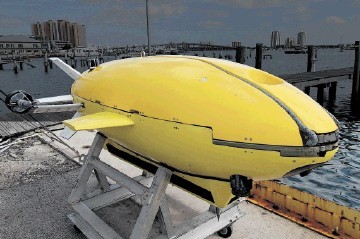
Lockheed Martin has developed a 3m (10ft) unmanned submarine named Marlin that uses sonar and other technologies to inspect offshore oil rigs “faster and at lower cost than current systems”.
The vehicle was tested quietly last summer in the Gulf of Mexico at a facility owned by Chevron, generating detailed 3D data that piqued a great deal of industry interest.
Now the company is putting the unit to work offshore Louisiana. The first contract is with an as yet unnamed company; the task is to assess a number of shallow-water platforms.
The new Marlin system can be programmed to autonomously survey an underwater object and detect any changes. According to Lockheed, it can map a 40m (135ft) platform in 27 minutes and then generate 3D models.
It is currently able to dive to 3,00m (1,000 ft), but Lockheed is working on making it capable of reaching water depths of 3,500m (12,000ft), according to Marlin’s creator, Dan McLeod.
This autonomous underwater vehicle (AUV) has been developed with civilian and military use in mind and enters a still thinly populated marketplace where perhaps the Hugin AUV is the best known and most established.
According to Lockheed, the hydrodynamic design and thruster arrangement enables hover capability and high maneuverability in tight spaces. The US defence corporation says it is as much at home in marine as freshwater environments.
A fully-integrated autonomous launch and recovery system has been developed and built as a part of this, the first Marlin package.
Lockheed says: “The Marlin AUV is well-suited for use in the oil and gas industry to inspect offshore structures and pipelines, especially after severe weather strikes, such as hurricanes.
“We developed the Marlin from our extensive AUV systems experience to fill a need in the commercial sector.”
The project, first initiated in mid-2009, is said to reflect growing efforts by big weapons makers like Lockheed to find revenues in adjacent markets as they brace for curtailed defence spending in Europe and the US.
If this is the case, then it repeats a cycle that has been witnessed in the North Sea several times over since the late 1960s when the Southern Gas Basin was first exploited.
Rich Holmberg, VP at Lockheed’s mission and unmanned systems unit in Florida has claimed that the corporation was the only company with the full set of capabilities offered by the Marlin vehicle at the moment.
The mission and unmanned systems unit has historically been more of a research house, like Lockheed’s famous Skunk Works aeronautics development shop, which has earned it the nickname “Squid Works,” but it is ramping up for a higher profile.
While other parts of Lockheed are laying off workers, Holmberg’s unit has filled 130 positions over the past 18 months, bringing its workforce to 430 people to deal with demand for Marlin and complete work on several US Navy programs, including a remote mine-hunting system for coastal warships.
It also just opened an office in Houston to capitalise on oil and gas opportunities.
Industry data shows there are over 3,800 offshore platforms in the Gulf of Mexico alone; more than 40,000 miles of underwater pipeline, and an estimated 12,000 capped wells – all of which are subject to various government inspection requirements.
Recommended for you
